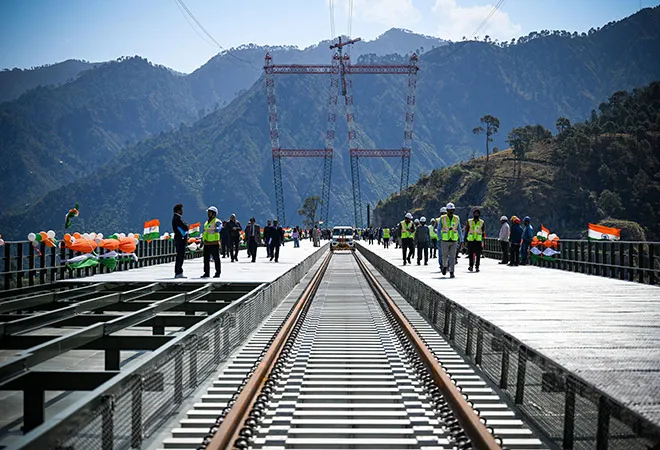
On 16 March, the much-
awaited T-5 tunnel at Panthyal in the Ramsu area of Kashmir’s Ramban district became open to the public. This 870-meter-long tunnel was completed in four years, incurring a cost of
INR 100 crores. The Panthyal stretch of the strategic national highway (NH44) was the project’s
most vulnerable portion; it was considered a death trap by drivers and commuters because of frequent landslides. In September last year, increased landslides and geological instability halted transportation along the corridor, causing a
loss of more than INR 1,500 crores to the apple industry, the backbone of Kashmir’s economy. The losses from the road closure led to
valley-wide protests by fruit growers and merchants. The Kashmir Valley produces about 75 percent of the apple crop in India and
contributes about 8.2 percent to the GDP of the Union Territory (UT) of Jammu and Kashmir. The UT administration expedited the construction of connectivity projects, including the T-5 tunnel, but only after New Delhi intervened. Many multimodal connectivity projects that are expected to transform the Valley economically are under construction to link Kashmir with the rest of India. Once completed, these projects will pave the way for greater integration of the people of Kashmir with the Indian mainland and will significantly aid in reducing the Pakistan-imbibed sentiments of separatism.
Many multimodal connectivity projects that are expected to transform the Valley economically are under construction to link Kashmir with the rest of India.
Different connectivity projects in Kashmir
Under Prime Minister Narendra Modi’s leadership in the last decade, India has taken unprecedented strides to boost connectivity infrastructure for the rapid economic transformation of the nation. The government is building world-class highways, airports, and new high-speed railways to facilitate smooth and speedy travel via road, rail, and air. New Delhi is adding
10,000 km of highways every year, the number of airports has doubled, and the rural road network reached 729,000 km this year. Union budgetary allocations to these projects have increased enormously to
1.7 percent of GDP, with the Prime Minister personally conducting a monthly review of their progress.
Similarly, one of these projects—focused on establishing direct rail connectivity in the hitherto poorly-linked geostrategically-critical Kashmir Valley—has gotten special attention from New Delhi.
The 272-km Udhampur-Srinagar-Baramulla Rail Link (USBRL) project, declared a “National Project” in 2002, is slated for completion by 2025. USBRL’s sanctioned cost of
US $4.4 billion was divided into four phases. The 118-km long Baramulla-Qazigund section was
commissioned in 2009, the 19-km Qazigund-Banihal in 2013, and the 25-km Udhampur-Katra section, in 2014. The work on its remaining
111-km Banihal-Katra section, that runs through the rugged Himalayan terrain, is underway. Once completed, USBRL,
with 38 tunnels, including the longest 12.77-km T49 tunnel, will signify a marvellous engineering feat for India.
The world's highest Chenab Bridge (1,315 mt) and the first cable-stayed rail bridge, adds to the beauty of this rail connectivity project.
Furthermore, the world's highest
Chenab Bridge (1,315 mt) and the first cable-stayed rail bridge, adds to the beauty of this rail connectivity project. However, the project, which has been delayed by
litigation, complex geology, inaccessible sites and law and order issues, is also now directly monitored by the
Prime Minister and Railway Minister on a priority basis. It is now expected to be completed by
the end of this year. Recently, Northern Railways
have run track-mounted vehicles for a trial run on the iconic Chenab Bridge.
In 2011, the Government of India also undertook the work to widen the strategic
295-km highway (NH44) into a four-lane road. The four-lane expansion was divided into six projects, of which four projects are complete. The treacherous terrain, sinking soil and other geological challenges led to a comprehensive realignment of the remaining Banihal-Ramban road (36 km) and Ramban-Udhampur road (43 km). With the revised estimated cost of INR 5118 crores, this 79 km-long four-lane stretch of the NH44 will have 14 tunnels, including the recently opened Panthyal tunnel, between Banihal-Ramban-Udhampur. The work on the strategic highway will be completed by
August 2025, reducing the travel time from Srinagar to Jammu to four hours from the current 12 hours.
Bridging gaps in integration
Reliable connectivity and transportation within the UT and between the region and the rest of India are critical for India’s economic growth. Poor connectivity has negatively impacted the economic development of 70 percent of the Valley's population, which is dependent on farming and perishable fruit cultivation. The completion of these infrastructure projects will boost the development of the region’s horticulture sector, a mainstay of the region’s economy. The railway transport system is
four times more economical and six times more energy efficient than roads. Railway connectivity will thus not only cut transport costs but ensure minimum wastage of the perishable farm products and timely supply of fresh produce to different markets across India. Similarly, the free movement of agricultural goods on the highway will be a game changer for the Valley's farmers.
The completion of these infrastructure projects will boost the development of the region’s horticulture sector, a mainstay of the region’s economy.
These infrastructure projects will also give an impetus to the region’s tourism industry, enable it to achieve its full potential, and reduce the UT’s soaring unemployment rate, as new destinations will emerge along these new connectivity corridors. Jammu & Kashmir has once again emerged as India’s favourite tourist destination post-2019; in 2022,
1.88 crores of domestic and international tourists visited the UT. Revival of tourism will mean that the UT administration will have to create additional tourism infrastructure. The Kashmir Valley’s total registered bed capacity is only 62,488 beds, mainly around popular tourist spots like the Dal Lake, Pahalgam and Gulmarg. Other destinations like Peer Ki Gali, Doodhpathri, Gangbal, Sonmarg, and Yousmarg lack basic tourism facilities and amenities. The UT administration should prioritise essential infrastructure to accommodate the growing number of tourists and promote newer destinations.
On the other side, seamless connectivity with the rest of India will help and encourage local students to travel to different parts of India for education and employment. Greater assimilation with other parts of India will facilitate the much-needed revival of Kashmir’s syncretic culture and foster purposeful integration of the region’s society. Last but not least, these infrastructure projects will give India a strategic advantage. New Delhi can move the defence equipment and forces to border areas faster in case of any eventuality.
The views expressed above belong to the author(s). ORF research and analyses now available on Telegram! Click here to access our curated content — blogs, longforms and interviews.



 On 16 March, the much-
On 16 March, the much- PREV
PREV


